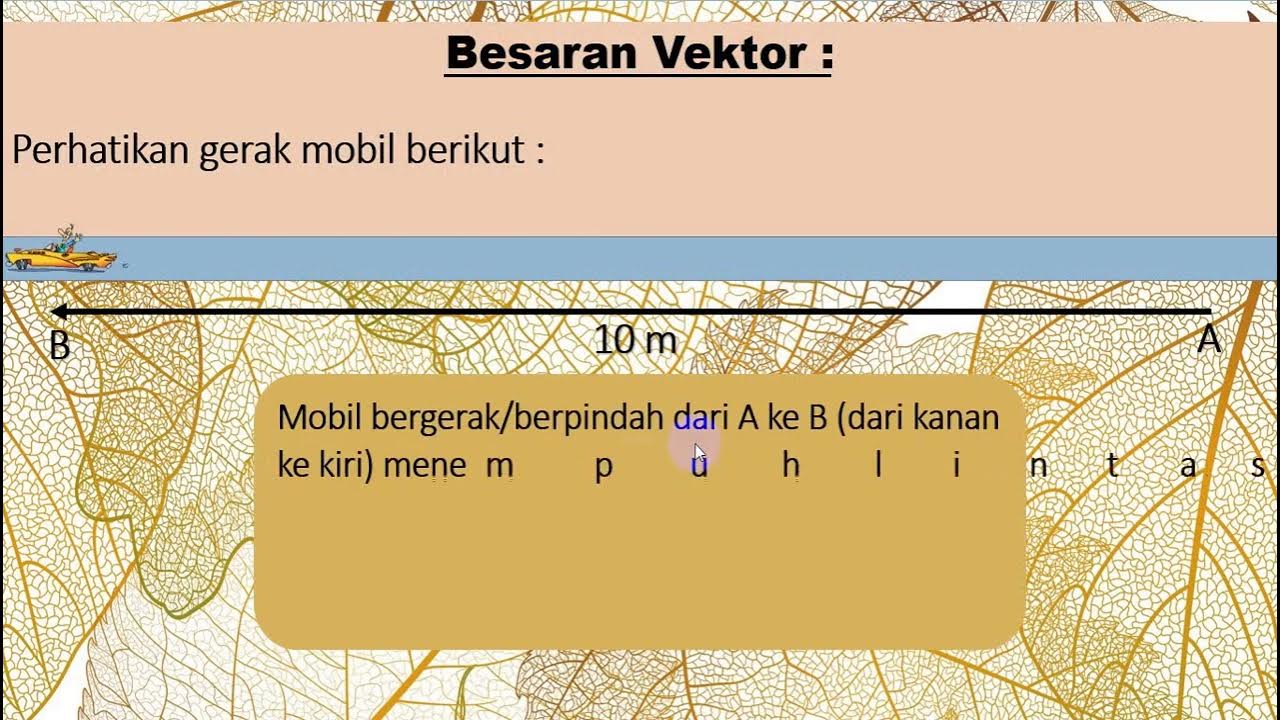Konsep Dasar Vektor (Vektor Bagian 1) Matematika Peminatan Kelas 10 - m4thlab
Summary
TLDRIn this video, Dini Handayani explains the basic concepts of vectors, distinguishing between scalar and vector quantities. Scalars have only magnitude, like distance and speed, while vectors have both magnitude and direction, such as displacement and force. Using examples, she demonstrates how to calculate distance and displacement and explains how opposite directions affect vector values. The video also covers how to represent vectors with arrows, how to calculate and draw vectors in both 2D (R2) and 3D (R3) spaces, and includes practice exercises to test understanding.
Takeaways
- 📏 Vectors are quantities that have both magnitude and direction, unlike scalars, which only have magnitude.
- 🧭 Scalars include quantities like distance, area, volume, power, and speed, while vectors include displacement, velocity, acceleration, and force.
- 🔀 Distance is a scalar, while displacement is a vector. In an example, a person walks from point A to B (10 meters), then from B to C (4 meters). Total distance traveled is 14 meters, but displacement is calculated considering direction.
- ➕ For vectors, if directions oppose each other, the vector in the opposite direction is subtracted. In the example, displacement is 6 meters because 10 meters minus 4 meters gives the net result.
- ⚖️ When forces oppose each other, their values are subtracted. For example, a 100N force pushing right and a 120N force pushing left results in a net force of -20N, meaning movement is to the left.
- 🎯 Vectors are represented graphically by arrows, where the length of the arrow shows magnitude, and the direction indicates vector direction.
- 🧮 Vector notation can use uppercase letters with arrows, lowercase letters with underlines, or bold letters. The most common format is uppercase with arrows.
- 🛠️ In 2D vector representation, the first component refers to horizontal movement, while the second refers to vertical movement. Positive values represent rightward or upward movement, and negative values represent leftward or downward movement.
- 📊 For 3D vectors, there are three components: x (horizontal), y (right-left), and z (up-down). Positive and negative values depend on the direction.
- 📚 The video concludes with vector-related exercises, including identifying vectors from graphs and drawing vectors based on provided coordinates.
Q & A
What is the main difference between scalar and vector quantities?
-The main difference is that scalar quantities have only magnitude (value), while vector quantities have both magnitude and direction.
Can you give examples of scalar and vector quantities?
-Scalar quantities include distance, area, volume, power, and speed. Vector quantities include displacement, velocity, acceleration, and force.
How is distance different from displacement?
-Distance is a scalar quantity that only measures how much ground an object has covered, regardless of direction. Displacement, however, is a vector quantity that measures the shortest path between the starting and ending points and includes direction.
In the given example, if a person walks from point A to point B (10 meters) and then from B to C (4 meters), what is their total distance traveled?
-The total distance traveled is 14 meters, as distance is a scalar quantity and is simply the sum of the distances (10 meters + 4 meters).
How is displacement calculated in the same example when the person walks from A to B and then to C?
-Displacement is calculated by considering the direction. Since the person changes direction at point B, the displacement is 6 meters, calculated as 10 meters (A to B) minus 4 meters (B to C), as direction affects displacement.
What happens to the value of force when two forces act in opposite directions?
-When two forces act in opposite directions, the resulting force is the difference between the magnitudes of the forces, and the direction of the resulting force is determined by the stronger force.
How is force represented when one person pushes an object to the right with 100 N and another to the left with 120 N?
-The net force is -20 N, where the negative sign indicates the direction is to the left, as the leftward force is stronger.
How do you represent a vector graphically?
-A vector is represented graphically by an arrow. The length of the arrow represents the magnitude of the vector, and the direction of the arrow shows the vector's direction. The starting point is called the tail, and the endpoint is called the head.
How do you interpret the vector (3,4)?
-The vector (3,4) means the object moves 3 units to the right (horizontal direction) and 4 units upwards (vertical direction).
How would you draw a vector on a 3D space?
-In 3D, vectors are represented by three components (x, y, z) and are plotted using three axes: the x-axis (front-back), y-axis (left-right), and z-axis (up-down). For example, the vector (2,3,5) moves 2 units forward, 3 units to the right, and 5 units upwards.
Outlines

Cette section est réservée aux utilisateurs payants. Améliorez votre compte pour accéder à cette section.
Améliorer maintenantMindmap

Cette section est réservée aux utilisateurs payants. Améliorez votre compte pour accéder à cette section.
Améliorer maintenantKeywords

Cette section est réservée aux utilisateurs payants. Améliorez votre compte pour accéder à cette section.
Améliorer maintenantHighlights

Cette section est réservée aux utilisateurs payants. Améliorez votre compte pour accéder à cette section.
Améliorer maintenantTranscripts

Cette section est réservée aux utilisateurs payants. Améliorez votre compte pour accéder à cette section.
Améliorer maintenantVoir Plus de Vidéos Connexes

Fisika SMA - Vektor (1) - Pengenalan Vektor, Besaran Vektor dan Skalar, Melukis Vektor Satuan (I)

Besaran vektor dan besaran skalar (Fisika SMA/MA Sagufindo kls X smt 1 : Vektor)

Besaran Vektor | Vektor | Part 1 | Fisika Dasar

Perkalian Skalar Dua Vektor | Perkalian Titik | Dot Product (Vektor Bagian 7) MTK Peminatan Kelas X

Panjang Proyeksi dan Proyeksi Skalar (Vektor Bagian 8) | Matematika Peminatan Kelas X

Vektor.
5.0 / 5 (0 votes)
